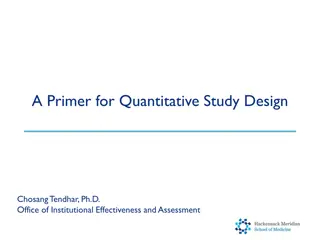Framing Research Questions for Effective Study Design
Beginning a research project involves framing a clear question that leads to a hypothesis, aims, and approach. This process requires careful consideration of which questions to pursue and how to develop them into a study. From tentative questions to testable statements, refining the research question is crucial for successful research design. It is also important to assess the significance of the question, existing studies, timing, and knowledge gaps before proceeding to the methodology phase. A literature review can provide valuable insights for further development of the research question.
Download Presentation

Please find below an Image/Link to download the presentation.
The content on the website is provided AS IS for your information and personal use only. It may not be sold, licensed, or shared on other websites without obtaining consent from the author.If you encounter any issues during the download, it is possible that the publisher has removed the file from their server.
You are allowed to download the files provided on this website for personal or commercial use, subject to the condition that they are used lawfully. All files are the property of their respective owners.
The content on the website is provided AS IS for your information and personal use only. It may not be sold, licensed, or shared on other websites without obtaining consent from the author.
E N D
Presentation Transcript
Framing Your Research Question Alison K. Hall, PhD Associate Dean, Research Workforce Development November 12, 2019
Framing the Question Research begins with a question, that leads to a hypothesis that leads to aims and approach You have lots of questions Which do you pursue? How do you develop a question into a study? Study Design & Methodology Data collection & Analysis Hypothesis/ Aims Question
Your Questions from Pre-Work? IPPCR #50: A Research Question and Implications for Efficient Clinical Trials Scientific validity--study addresses the research question that was posed the knowledge gap 16:50 19:50 choosing a design 35:30 Outcomes and measures
Start with a Research Question Tentative question, often from a hunch Which patients presenting with coma are most likely to return to the ED? Why are numbers of children with obesity increasing? List 3 of your own research questions now share with group
What might affect the study? Which patients presenting with coma are most likely to return to the ED? Why are numbers of children with obesity increasing? question might go in several directions biomarker Prospective survey Retrospective study Randomized clinical trial What might impact direction to pursue?
From question to something testable Which patients presenting with coma are most likely to return to the ED? Why are numbers of children with obesity increasing? Pare down question to a statement of something testable Absence of regular exercise leads to an increase in weight during elementary school. Systolic blood pressure and type of trauma are associated with subsequent readmission.
Right about now, you need to know more Is question important? Has it been studied before? Is the timing right to answer this now? What is the knowledge gap? Insight into methodology? A good literature review! http://guides.himmelfarb.gwu.edu/c.php?g=27724&p=4447440
Librarian Assists Systematic Review Systematic Review Service Himmelfarb Library info Systematic Reviews Research Guide here Liason librarian or Elaine Sullo (elainej@gwu.edu or 202-994-2853) Essential research step, might be a research product
Formulating the Question: PICOT Specify the patient population (P), the intervention of interest (I), the comparator (C), the outcomes of interest (O), the study time period, when outcomes measured (T) How broadly to define the patients? How to define intervention (dose, intensity, setting)? Is your study ethical? Try PICOT on your first research question, now
How broadly to define? effects of antiplatelet agents on vascular disease include only patients with transient ischemic attacks those with ischemic attacks and strokes those with any vascular disease (cerebro-, cardio-, or peripheral vascular disease). intervention might be a relatively narrow range of doses of aspirin; all doses of aspirin; or all anti-platelet agents. Generally want broad eligibility criteria Specify a priori possible explanations of variability in study results for each PICOT element
PICOT P- Population; elderly? Particular condition? Healthy? Urban? I- Intervention; analytic, experimental , comparison group? C- Comparison O-Outcome; disease, parameter of interest-pain, T-Time period, when outcomes measured, reflect study period Your other 2 questions Read More: https://www.evidencepartners.com/resources/methodologic al-resources/framing-the-question-and-a-priori-hypotheses/
Research Questions Lead to Study Design Observational study to find associated risk factors or predictors for suicide among adolescents 10- 19 yrs. Geriatric population, community hospital, exposed to new drug, compared to standard drug for relief of pain. Case control-one group committed suicide other group did not, within 3 years time. Interventions might be therapeutic, diagnostic, prophylactic, surgical, etc Assess risk factors in both groups like drug use, stress, academic performance, etc Outcomes can be subjective, objective, biological, lab, radiological, etc A good research question has logical clarity, leads to study design
Little data exist on the use of pharmacological treatments for osteoarthritis in very old people Important, painful joints affect activity relevant, because of the ageing population, comorbidity One drug versus combination? One joint versus another (elbow, knee)? Many trials are short term (eg 6 weeks) Affect clinical practice (dose escalation, substitution)?
Do you proceed? FINER Characteristics of a good research question F-feasibility; resources, time, stat power, expertise I-Interesting; to investigator, subjects N-Novelty; innovation, interest to funders? E-Ethical, safeguard interests of participants (IRB etc) R-Relevant If feasible but not valid, unethical! Nice questions at scalelive.com You can t decide without a grounding in the literature. Is your study feasible? Consider any modifications
Research Strategy A strong research idea should pass the so what test. What is the benefit of answering your question? What is the purpose of your research? Why did you chose the approach? Consider anticipated results and alternatives How the proposed studies will move the field forward?
Leads to a Hypothesis A statement. Defines the assumption you are to test. Example: Study elderly subjects and drug for knee osteoarthritis. Test two drugs, ABC and ibuprofen; measure is relief of pain Hypothesis spells out anticipated relationship between variables. May be true/not true Drug ABC is superior to standard for knee pain relief. One sided to find superior, two sided if equivalent; Hypothesis has impact on power and sample size State hypothesis for your research question
Experimental Design How will you test hypothesis? What is experimental approach? Describe sample sizes, blinding, statistics, controls, replication Cite papers, but do not expect reviewer to read What are Anticipated outcomes? What are Alternative approaches
Objectives are SMART action points Objectives can be action points you want to achieve in study Example: Study elderly subjects and drug for knee osteoarthritis. Test two drugs, ABC and ibuprofen; measure is relief of pain Specific Measurable pain scale, quality indicator, joint deterioration Achievable ambulatory, education, annual assessment Realistic resources to do it? Timed 6 months, 1 year self management, carer
Methodology & Biostats Consult Helpful formulas Sensitivity and specificity False positive false negative Predictive value Relative risk Odds ratio Grad Cert, MS Clinical Research CRA 6205 Clinical Investigation CTS 6202 Res Meth CTR CTS 6203 Legal Ethical Issues CTR CTS 6246 CTR Capstone Project HSCI 6263 Biostatistics for CTR HSCI 6264 Epidemiology for CTR Biostatistics & Epidemiology Consult Service: CTSI-CN SPARC Request Study Design 101 online tutorial help What s your approach?
Where does this fit in Specific Aims Provide 2 or 3 aims Address a hypothesis that is logical, testable, focused, informative, simple Specific Aims Handout Sample structure: First paragraph: Capture attention-hook, what s known, the gap you will address, why it s important Second Paragraph: Introduce your solution to fill the gap Each Aim: Devote a short paragraph to each aim Summary Paragraph: What new things we will know, why the application should be supported now Consider: Models/Charts/Diagrams
Framing the Question Research begins with a question, that leads to a hypothesis that leads to aims and approach Study Design & Methodology Data collection & Analysis Hypothesis/ Aims Question























